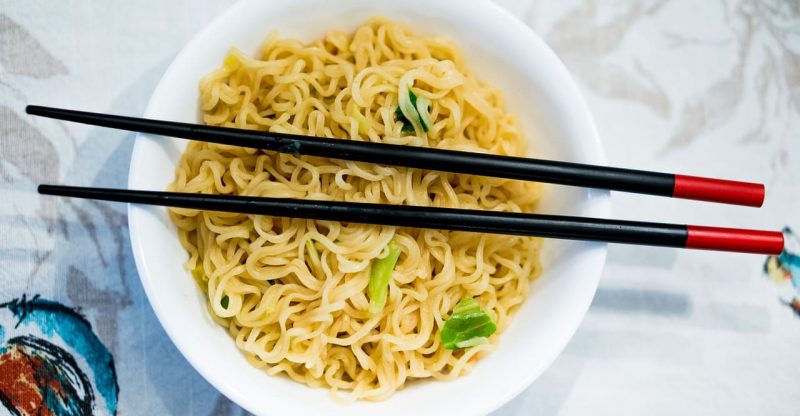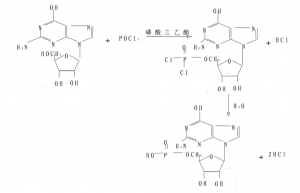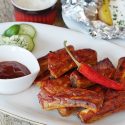What Is Disodium Guanylate (E627) In Food? Uses, Safety, Side Effects

Production | Uses | Safety | Side Effects | FAQs
Disodium guanylate or disodium 5′-guanylate, a flavor enhancer with the European food additive number E627. It is a kind of nucleotide and usually added with another flavor enhancer disodium inosinate (E631) in food and the combination is known as disodium 5′-ribonucleotides (E635), which is an MSG substitute.
How is it made?
It is the organic disodium salt of guanylic acid powder or granular, the manufacturing processes are similar with that of producing disodium inosinate. Here are two methods:
One process starts from sugar fermentation to obtain guanosine and subsequently react with phosphoryl chloride and then neutralize with NaOH. Following is the reaction equation of guanosine and phosphoryl chloride.
It can also be made from yeast extract.
Properties
| Other names | GMP or Disodium guanylate-5′-monophosphate |
| CAS number | 5550-12-9 |
| Chemical formula | C10H12N5Na2O8P |
| Molecular weight | 407.19 (anhydrous) |
| Solubility | Soluble in water, 1:4; sparingly soluble in ethanol, practically insoluble in ether. |
| Stability | It has a strong water absorption, it can absorb 30% water if put in the humidity 70%. Decompose around 250 degree. |
Structure

From Wikepedia
What are the uses?
Disodium 5′-guanylate is a flavor enhancer that can be used in many processed foods to strengthen the umami taste or generate a savory, meaty, or broth-like taste, commonly by the combination with MSG or conjunction with disodium inosinate.
Its flavor-enhancing power is around 2 times of disodium 5′-inosinate.
The common applications include instant noodles, snack food, potato chips, sauces, tinned vegetables, cured meats and so on.
With MSG
It has a significant flavor synergy with monosodium glutamate (MSG) to provide umami taste.
MSG Substitute
It can be used in food as an MSG replacement when combined with disodium inosinate. The mixture is called disodium 5 ribonucleotides or I+G.
The following foods may contain it with maximum levels (as guanylic acid) from 500 mg/kg to not specific (1):
- Dairy products
- Fats and oils
- Edible ices
- Fruit and vegetables
- Confectionery
- Cereals and cereal products
- Bakery wares
- Meat
- Fish and fisheries products
- Eggs and egg products
- Sugars, syrups, honey and table-top sweeteners
- Salts, spices, soups, sauces, salads and protein products
- Beverages
- Seasonings and condiments
Is disodium guanylate safe to eat?
Yes, its safety when used as a food additive has been approved by the U.S. Food and Drug Administration (FDA), European Food Safety Authority (EFSA), Joint FAO/WHO Expert Committee on Food Additives (JECFA), as well as other authorities.
FDA
FDA claimed disodium guanylate is a direct food additive that may be safely used as a flavor enhancer in foods. (2)
EFSA
Disodium guanylate (E627) is listed in Commission Regulation (EU) No 231/2012 as an authorised food additive and categorized as “additives other than colours and sweeteners” (3)
Safety assessment
Published in March, 2017: EFSA has not previously assessed it as a food/feed additive but sourced the data from the Scientific Committee for Food (SCF) and JECFA. (4)
Published in Oct, 2018: Like disodium inosinate, its usage level in food and beverages needs to be re-valuated. (5)
UK Food Standards Agency
Categorized in “Others” (6)
Food Standards Australia New Zealand
It is anapproved ingredient in Australia and New Zealand with the code number 627. (7)
JECFA
Functional class: Food additives: flavor enhancer. (8)
Acceptable daily intake: ADI “not specific” was set in 1993. (9)
What are the Possible Side Effects?
It is common that sometimes consumers have concerns if disodium guanylate is bad for our health and what are the dangers. It is generally considered safe and almost has no reported side effects. From the report of JECFA in 1993, no caused carcinogenicity, teratogenicity, genotoxicity, adverse effects on reproduction, and short and long term toxicity.(10).
Is it safe for pregnant?
It is generally safe but better consult your doctor.
Frequently asked questions
Is GMP Natural?
Yes, it is a natural flavor enhancer widely presented in animal and plant tissues. It has a high content in mushrooms and with a strong mushroom flavor. It can also be naturally found in sardines and yeast extract.
Is GMP Vegan?
Yes, disodium 5′-guanylate is vegan if produced in the above two methods as the raw material guanosine and manufacturing process without the use of animal matter or products derived from animal origin. As a food ingredient, it is considered vegan and suitable to add to the diet of vegetarians.
However, it may also be derived from animal sources which is stated in an early study in 1988 that said guanylic acid (sodium guanylate) may came from animal sources (11). So vegetarians should avoid if it is made in this way.
Is GMP Halal?
Yes, it is generally recognised as halal as it is permitted under the Islamic Law and fulfill the conditions of Halal. And we can find some manufacturers certificated with MUI halal.
Is GMP Kosher?
Yes, it is kosher pareve. E627 has met all the “kashruth” requirements and can be certified as kosher.
Is GMP Gluten free?
Yes, it is gluten free or without gluten as it complies with the FDA’s definition of gluten free, that it does not contain wheat, rye, barley, or crossbreeds of these grains.
Conclusion
Now you may have a good knowledge of the flavour enhancer – disodium guanylate (E627), from its production, uses, approved safety, possible side effects and some FAQs such as is it vegan, gluten free, synthetic or natural.
What kinds of food packaging have you found this ingredient in? Let me know in the comments.



Thank you very much for the information provided
I’m very impressed
hi,
tks for y/data.
i found this Thai black pepper sauce using E627 and E631 together.
Rgds.
the sauce brand is MAEPRANOM BRAND.
It is in Kernel Season’s brand of popcorn seasoning called Nacho Cheddar. I had never heard of disodium guanylate until checking everything I consumed in the last 12 hours because of the vomiting episodes I had last night. Won’t be putting this on my popcorn again and will be looking for it in future processed foods so I can avoid it. I have a sensitivity to MSG so it is good for me to know to stay away from this as well.
Found E627 in Amoy Light Soy Sauce.
Thank you for the information.
It’s just another way to make money harming people, since consumers started being aware of MSG. It is as toxic as MSG or more, just a matter if you are tomorrow vomiting, having a migraine crisis, etc., or are just having dementia at 60 years old. Avoid.
hi, it was in a pack of Fritos chili cheese corn chips along with disodium insinuate and msg.